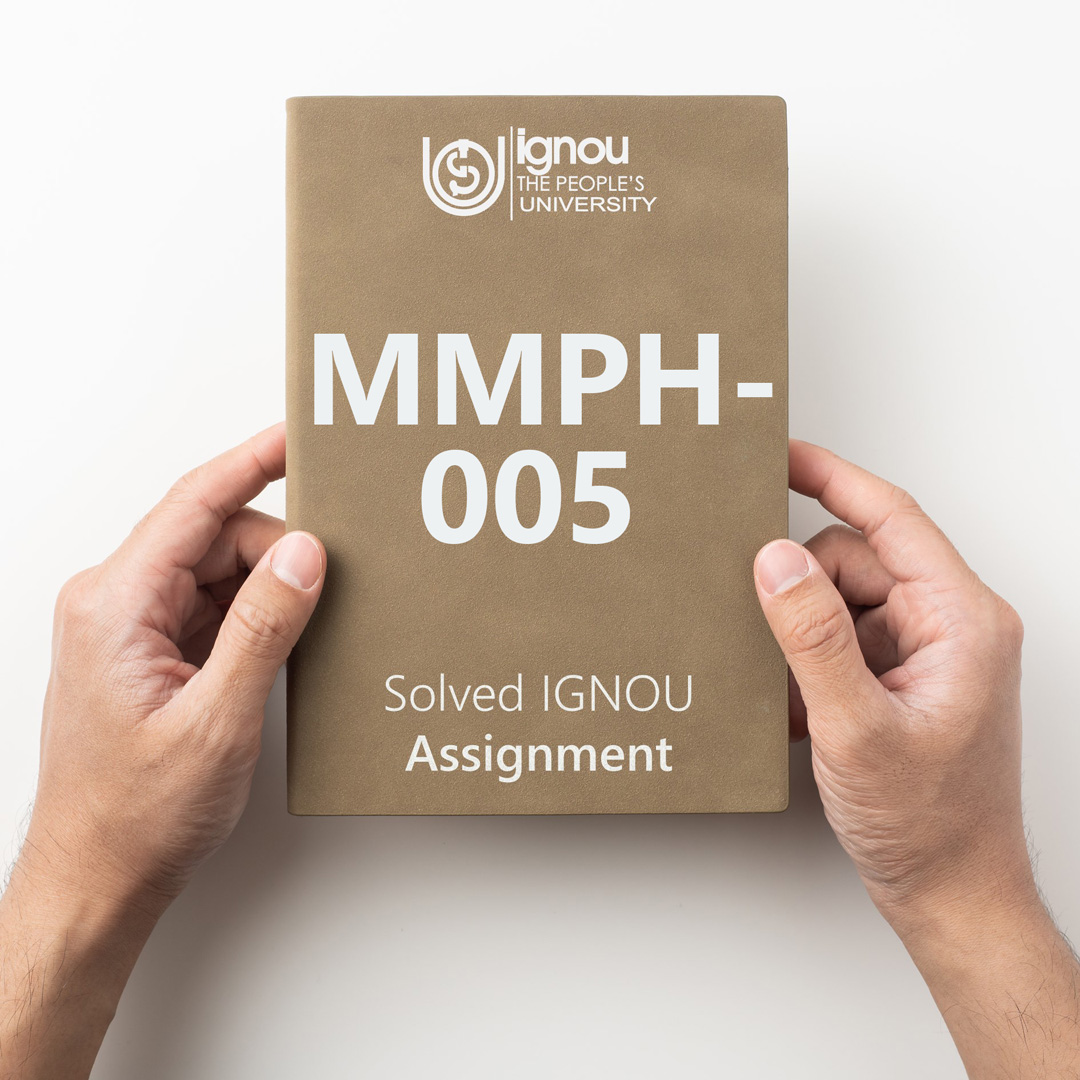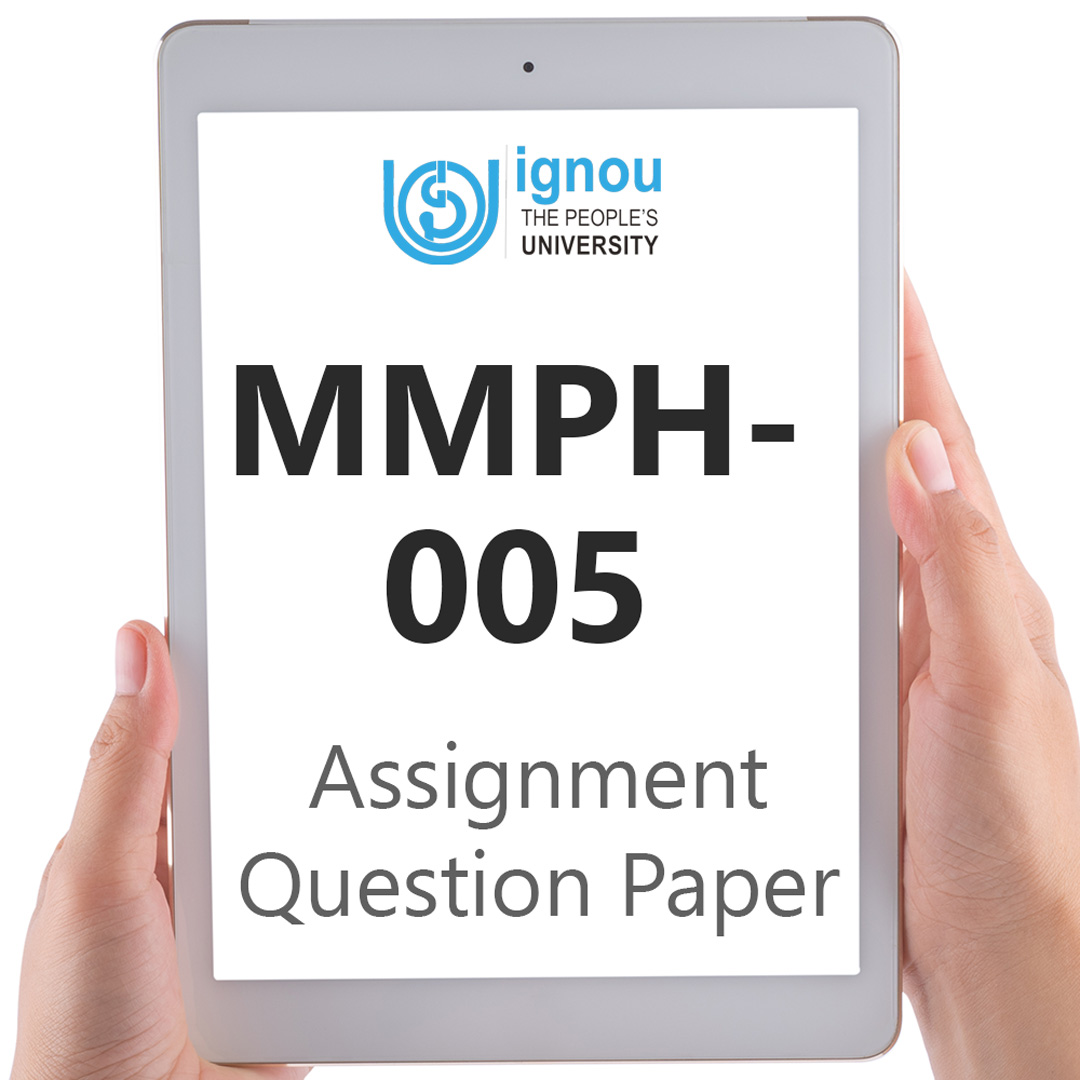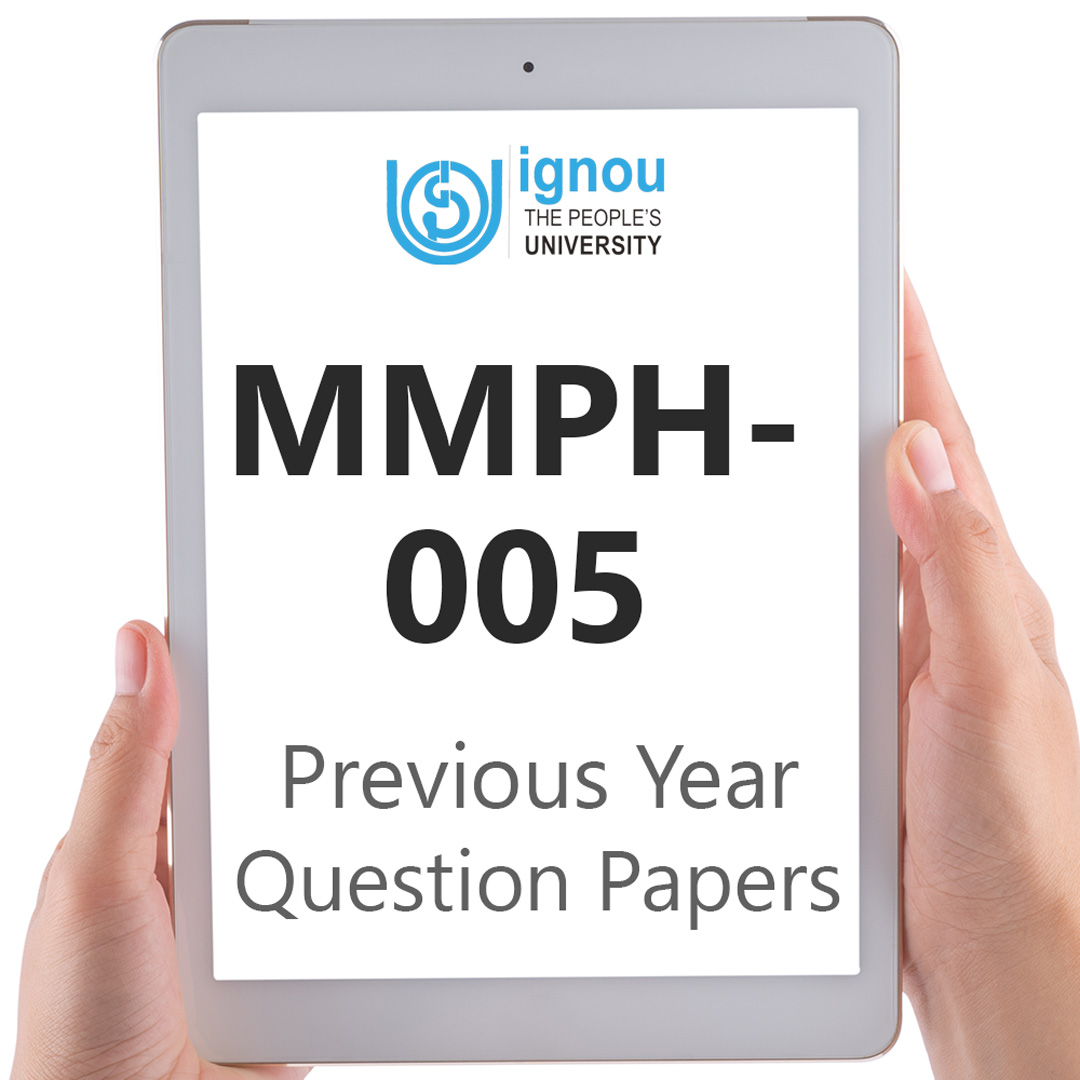If you are looking for MMPH-005 IGNOU Solved Assignment solution for the subject Organizational Development and Change, you have come to the right place. MMPH-005 solution on this page applies to 2023 session students studying in PGDIHRM, MBA, MBAHM courses of IGNOU.
MMPH-005 Solved Assignment Solution by Gyaniversity
Assignment Code: MMPH-005/TMA/JAN/2023
Course Code: MMPH-005
Assignment Name: Organisational Development and Change
Year: 2023
Verification Status: Verified by Professor
Q1) Discuss the importance of Managing change in organisations. Describe any three methods to bring change in organisations and their relevance. Discuss with examples.
Ans) Change is an inevitable aspect of organizational life. Organizations must continually adapt to changes in the business environment to remain competitive and meet the needs of their stakeholders. Effective change management is critical to the success of an organization, and failure to manage change can have negative consequences.
Importance of Managing Change in Organizations
Maintain Competitiveness: Organizations that do not adapt to changing market conditions risk falling behind their competitors. Effective change management allows organizations to stay ahead of the competition by adapting to changes in the business environment and taking advantage of new opportunities.
Increase Efficiency: Change management can help organizations to increase their efficiency by streamlining processes, eliminating waste, and reducing costs. By continually looking for ways to improve, organizations can operate more efficiently and effectively.
Enhance Employee Engagement: Change management can help to enhance employee engagement by involving employees in the change process and providing them with the resources they need to succeed. By involving employees in the change process, organizations can create a sense of ownership and accountability that can lead to increased motivation and productivity.
Three Methods to Bring Change in Organizations
Lewin's Change Management Model
Lewin's change management model is a three-step process that involves unfreezing the current state, making changes, and refreezing the new state. The first step involves creating a sense of urgency and identifying the need for change. The second step involves making changes and implementing new processes. The final step involves stabilizing the new state by reinforcing new behaviours and processes.
Example: A company that wants to implement a new customer relationship management (CRM) system can use Lewin's change management model. The company can begin by creating a sense of urgency around the need for a new CRM system. They can then implement the new system and provide training to employees to ensure they know how to use it effectively. Finally, the company can reinforce the use of the new system by providing ongoing support and incentives for employees who use it effectively.
Kotter's 8-Step Change Model
Kotter's 8-step change model involves eight steps that organizations can use to manage change effectively. The steps include establishing a sense of urgency, creating a powerful coalition, developing a vision and strategy, communicating the change vision, empowering others to act on the vision, creating short-term wins, consolidating gains, and producing more change, and anchoring new approaches in the organization's culture.
Example: A company that wants to implement a new sustainability initiative can use Kotter's 8-step change model. The company can begin by establishing a sense of urgency around the need for sustainability and creating a coalition of stakeholders who support the initiative. They can then develop a vision and strategy for sustainability and communicate it to all employees. The company can empower employees to act on the vision by providing them with the resources they need to implement sustainable practices. They can also create short-term wins by highlighting successes and progress towards sustainability goals.
Agile Change Management
Agile change management is a flexible and iterative approach to managing change that focuses on adapting to changing circumstances and feedback. This approach involves breaking down change into smaller, more manageable pieces and implementing them quickly. It also involves continuously evaluating the effectiveness of changes and adjusting as needed.
Example: A company that wants to improve its online customer experience can use agile change management. The company can begin by identifying the areas of the website that need improvement and breaking down the changes into smaller pieces. They can then implement the changes quickly and continuously evaluate their effectiveness. The company can adjust as needed based on customer feedback and other metrics to ensure they are meeting their objectives.
Q2) Explain the stages of organisation development (OD) and discuss its importance. Briefly discuss the factors contributing for the success of Organisation Development.
Ans) Organizational Development is a process of planned change aimed at improving organizational effectiveness and health. It involves a systematic approach to identifying and addressing organizational problems through collaboration and consultation with stakeholders. OD can help organizations adapt to changing environments, improve communication and teamwork, and enhance employee engagement and performance.
Stages of Organization Development
Diagnosis: The first stage of OD involves diagnosing organizational problems or issues. This stage involves gathering data through surveys, interviews, and observations to identify areas for improvement. The data is analysed to identify patterns and themes and develop a comprehensive understanding of the organizational issues.
Planning: The second stage involves planning for change. Based on the diagnosis, the organization develops a plan to address the identified issues. The plan includes specific goals, strategies, and action steps. The planning stage also involves identifying the resources needed to implement the plan and developing a timeline for implementation.
Intervention: The third stage involves implementing the planned changes. This stage involves the actual implementation of the strategies and action steps identified in the planning stage. The intervention stage may involve training, coaching, process improvement, or other interventions designed to improve organizational effectiveness.
Evaluation: The fourth stage involves evaluating the effectiveness of the interventions. This stage involves measuring the impact of the interventions on organizational effectiveness and health. The evaluation may involve surveys, interviews, and observations to measure changes in employee behaviour, attitudes, and performance.
Importance of Organization Development
Improved Organizational Effectiveness: OD can help organizations improve their effectiveness by identifying and addressing areas for improvement. By improving communication, teamwork, and employee engagement, OD can help organizations operate more efficiently and effectively.
Enhanced Employee Performance: OD can enhance employee performance by improving their skills, knowledge, and attitudes. By providing training and coaching, OD can help employees develop the skills and knowledge they need to perform their jobs more effectively.
Increased Adaptability: OD can increase organizational adaptability by helping organizations anticipate and respond to changes in their environments. By developing a culture of continuous improvement and learning, OD can help organizations stay ahead of the competition.
Factors Contributing to the Success of Organization Development
Strong Leadership: Effective leadership is critical to the success of OD. Leaders must be committed to the process and actively support the changes being made.
Employee Involvement: Employee involvement is essential to the success of OD. Employees must be involved in the diagnosis, planning, and implementation stages to ensure their buy-in and commitment to the process.
Clear Objectives: Clear objectives are critical to the success of OD. The objectives should be specific, measurable, achievable, relevant, and time bound. They should also be aligned with the organization's mission and vision.
Open Communication: Open communication is essential to the success of OD. Communication should be two-way and involve both formal and informal channels. Employees should feel comfortable sharing their thoughts, ideas, and concerns.
Ongoing Evaluation: Ongoing evaluation is critical to the success of OD. The organization must continuously evaluate the effectiveness of the interventions and adjust as needed to ensure they are achieving their objectives.
In conclusion, organization development is a process of planned change aimed at improving organizational effectiveness and health. The stages of OD include diagnosis, planning, intervention, and evaluation. OD can help organizations adapt to changing environments, improve communication and teamwork, and enhance employee engagement and performance. The success of OD depends on strong leadership, employee involvement, clear objectives, open communication, and ongoing evaluation.
Q3) What are the reasons for the formation of mergers and acquisitions. Discuss. Identify and explain the alternatives to mergers and acquisitions.
Ans) Mergers and acquisitions refer to the process of combining two or more companies into a single entity. There are several reasons why companies may choose to engage in M&A, including:
Synergy: M&A can create synergy, where the combined entity is more valuable than the sum of its parts. By combining complementary resources, knowledge, and expertise, companies can reduce costs, increase revenue, and gain a competitive advantage.
Diversification: M&A can provide companies with diversification, allowing them to enter new markets, expand their product or service offerings, and reduce their dependence on a single market or product.
Growth: M&A can be a strategic growth opportunity for companies that are looking to increase their market share, revenue, and profitability. By acquiring other companies, companies can quickly gain access to new customers, technology, and intellectual property.
Risk Reduction: M&A can also be a way to reduce risk. By diversifying their operations, companies can spread their risk across different markets and products, reducing their exposure to downturns in a single market or product.
While M&A can provide significant benefits to companies, there are also alternatives to consider:
Strategic Alliances: Strategic alliances involve partnerships between two or more companies that agree to work together on a particular project or objective. Strategic alliances can provide many of the same benefits as M&A, such as access to new markets and technology, without the complexity and risks associated with merging two companies.
Joint Ventures: Joint ventures involve two or more companies forming a new entity to pursue a common objective. Joint ventures can be a way to share costs and risks while gaining access to new markets, technologies, and expertise.
Organic Growth: Organic growth involves a company expanding its operations through internal development and investment, rather than acquiring other companies. While organic growth can be slower than M&A, it allows companies to maintain greater control over their operations and culture.
M&A can provide significant benefits to companies, including synergies, diversification, growth, and risk reduction. However, M&A is also complex and risky, and there are alternatives to consider, such as strategic alliances, joint ventures, and organic growth. Companies should carefully evaluate their objectives, risks, and resources before pursuing any growth strategy and select the option that best fits their needs.
Q4) Discuss the reasons for the resistance to change in organisations? Explain the sources of Resistance. Briefly discuss how to manage resistance with examples.
Ans) Resistance to change is a natural human response to the prospect of change in an organization. The reasons for resistance to change can be complex and varied, and they can stem from multiple sources. Understanding the sources of resistance is crucial for organizations to manage it effectively.
Reasons for Resistance to Change
Fear of the Unknown: One of the most common reasons for resistance to change is the fear of the unknown. Employees may be comfortable with the status quo, and the prospect of change can be unsettling, leading to resistance.
Loss of Control: Employees may resist change if they feel that they are losing control over their work processes or decision-making. Change can be perceived as a threat to their authority or autonomy, leading to resistance.
Lack of Trust: If employees do not trust the motives or intentions of the organization's leadership, they may resist change. Lack of transparency, communication, and involvement in the change process can contribute to this perception.
Job Insecurity: Employees may perceive change as a threat to their job security, leading to resistance. The fear of losing their job or not being able to perform in the new work environment can be a significant source of resistance.
Sources of Resistance to Change
Structural Barriers: Structural barriers can hinder the adoption of change. These barriers can be related to policies, procedures, technology, or physical infrastructure. For example, outdated technology can make it difficult for employees to adapt to new work processes.
Cultural Barriers: Organizational culture can be a significant source of resistance to change. If the culture is deeply entrenched in the status quo, employees may resist any change that threatens the existing norms and values.
Communication Barriers: Poor communication can lead to confusion and uncertainty, leading to resistance. If employees do not understand the rationale behind the change or how it will affect them, they may resist it.
Managing Resistance to Change
Communication: Effective communication is essential to managing resistance to change. Organizations should provide clear, timely, and relevant information about the change, its rationale, and how it will affect employees.
Participation: Involving employees in the change process can help reduce resistance. Organizations should provide opportunities for employees to provide feedback, ask questions, and participate in decision-making.
Education and Training: Education and training can help employees develop the skills and knowledge required to adapt to the new work environment. By investing in employee development, organizations can help employees feel more confident and less resistant to change.
Example of Managing Resistance
In the early 2000s, Apple Computer decided to switch from using IBM-compatible processors in its computers to processors made by Intel. This change was a significant shift for the company, and it faced resistance from employees who were accustomed to working with the IBM-compatible processors. To manage resistance, Apple provided training and education to employees to help them understand the benefits of the change. The company also involved employees in the decision-making process, providing them with opportunities to provide feedback and ask questions. By communicating the rationale behind the change and involving employees in the process, Apple was able to successfully manage resistance and make the transition to the new processors.
Resistance to change is a natural human response, and it can stem from multiple sources. Organizations must understand the reasons for resistance and the sources of resistance to manage it effectively. Effective communication, participation, education, and training can help reduce resistance and enable organizations to successfully implement change. By managing resistance to change, organizations can achieve their objectives, improve performance, and remain competitive.
Q5) Briefly discuss different types of interventions to be used in bringing change in organisations. Describe any three interventions and explain their merits and demerits with examples.
Ans) Organizational change is a complex process that requires careful planning and implementation. Different types of interventions can be used to bring change in organizations. Interventions refer to a set of planned activities that are designed to improve organizational effectiveness and promote change. There are various types of interventions, each with its own strengths and weaknesses.
Types of Interventions
Human Process Interventions: Human process interventions focus on improving interpersonal and group dynamics within an organization. These interventions include activities such as team building, conflict resolution, and leadership development. The aim of human process interventions is to improve communication, enhance teamwork, and develop leadership skills.
Technostructural Interventions: Technostructural interventions focus on improving organizational processes and systems. These interventions include activities such as job redesign, process improvement, and technology implementation. The aim of technostructural interventions is to improve efficiency, streamline processes, and reduce costs.
Human Resource Management Interventions: Human resource management interventions focus on improving the workforce's skills, knowledge, and abilities. These interventions include activities such as training and development, performance management, and succession planning. The aim of human resource management interventions is to improve employee performance, increase motivation, and promote retention.
Three Interventions and their Merits and Demerits
Team Building Intervention
Team building is a type of human process intervention that involves activities designed to improve communication, collaboration, and teamwork among employees. The merits of team building intervention are:
Merits
Improves communication and collaboration.
Increases productivity and performance.
Enhances employee engagement and job satisfaction.
Promotes a sense of teamwork and belonging.
Demerits
Can be time-consuming and expensive.
May not be effective if not well-planned and executed.
May not be suitable for all types of organizations and teams.
May not address underlying organizational issues.
Example: A manufacturing company implemented team-building activities for its production team, resulting in increased collaboration and reduced conflicts among team members.
Job Redesign Intervention
Job redesign is a type of technostructural intervention that involves changing the tasks, responsibilities, and duties of employees to improve efficiency and productivity. The merits of job redesign intervention are:
Merits
Improves efficiency and productivity.
Enhances employee engagement and job satisfaction.
Reduces turnover and absenteeism.
Increases creativity and innovation.
Demerits
Can lead to resistance and pushback from employees.
May require retraining and reskilling of employees.
May not be suitable for all types of jobs and positions.
May not address underlying organizational issues.
Example: A retail company implemented job redesign by automating its inventory management system, resulting in reduced errors and increased efficiency.
Succession Planning Intervention
Succession planning is a type of human resource management intervention that involves identifying and developing employees for future leadership roles. The merits of succession planning intervention are:
Merits
Ensures continuity of leadership and organizational stability.
Enhances employee engagement and retention.
Develops a talent pipeline for future leadership roles.
Increases motivation and job satisfaction.
Demerits
Can be time-consuming and expensive.
May not be effective if not well-planned and executed.
May not address underlying organizational issues.
May result in a lack of diversity in leadership.
Example: A healthcare organization implemented succession planning by identifying and developing its high-potential employees for future leadership roles, resulting in a more diverse and skilled leadership team.






